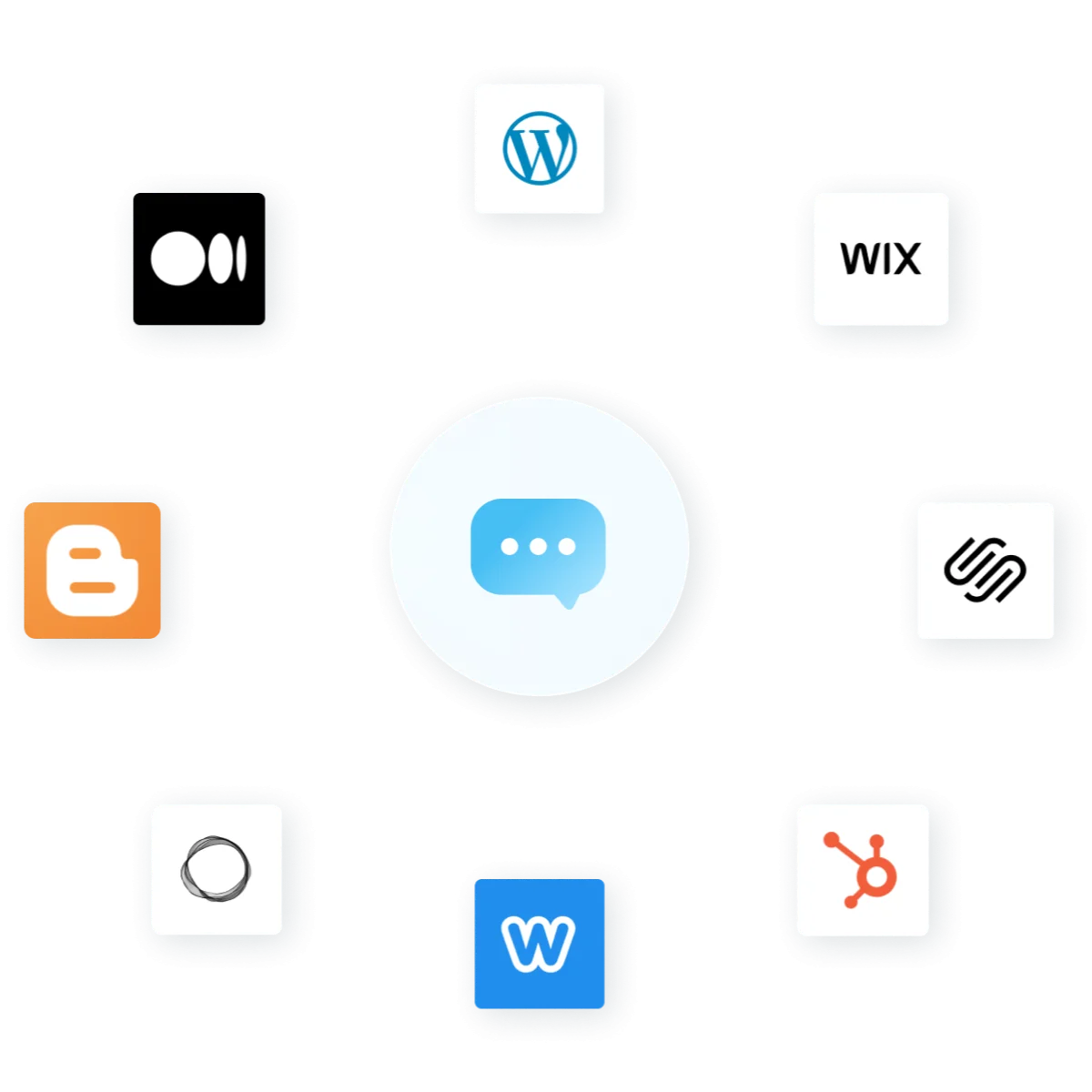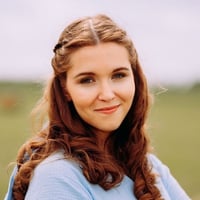What Is a Blogging Platform?
A blogging platform is a service that allows users to create, publish, and manage content on the internet, usually in the form of written posts. It’s designed to make publishing accessible for everyone, providing a structured space where writers, professionals, businesses, or hobbyists can share insights or personal stories with an online audience.
At its core, a blogging platform includes tools for composing, formatting, and editing text, as well as options for adding multimedia elements like images or videos. Most platforms offer templates and design features so users can personalize the look and feel of their blog without needing to learn coding. They also often include AI blogging tools, search engine optimization instruments and performance analytics.
Ultimately, such websites provide all the essentials you need to establish and maintain a blog, letting you focus on sharing your message with the world.
How to Choose a Blogging Platform
Choosing the right platform for your needs is the first step in creating a web blog. Here are the key factors to consider when making the selection:
1. Blogging features
Quality blogging tools, like content scheduling, RSS feed generation, and multimedia support, are valuable for building a dynamic blog. Look for a platform that has tools tailored specifically for bloggers, like tag categorization, comment moderation, and media integration.
2. Design flexibility
Look for a platform that allows customization for unique layouts, colors, and design elements, giving you flexibility whether you’re a beginner or a design pro. Also, take advantage of those platforms that offer blog templates and use them to match your style and brand.
3. Search engine optimization
Strong SEO tools will help your blog rank on search engines, driving organic traffic. Check if the platform offers built-in SEO features such as meta tag editing, alt text for images, and clean URLs. Some platforms also offer plugins or built-in SEO analyzers for further optimization.
4. Domain and branding options
Having a custom domain is key for professionalism and brand recognition. Some platforms provide free subdomains, while others allow for easy custom domain integration.
5. Monetization options
If you’re looking to make money from your blog, explore platforms that support various monetization options. These could include ad placement, affiliate marketing, e-commerce integration, or paid memberships. Some platforms make monetization easier with built-in tools.
6. Audience and popularity
A platform’s user base and popularity can indicate reliability and trustworthiness. Established platforms are often better supported, have robust feature sets, and have been improved over time based on user feedback.
7. Value for money
Compare the features you get for the platform’s price. Some platforms offer more storage, templates, and support for the price than others. Weigh what each platform provides to determine if it offers a good balance of features for its cost.
The selection criteria will mostly be based on your unique needs. Additionally, pay attention to factors such as third-party integration, customer support and resource library, etc. Also, read the reviews from other users to see how other blogs perform on this platform.
Best Website for Blog: Summary Table
| Platform | Blogging features | SEO tools | Monetization options | Pricing |
|---|---|---|---|---|
| WordPress | Extensive blogging tools with scheduling, RSS, tag categorization, and media support. | Excellent SEO tools; meta tag editing, alt text, clean URLs, and plugins like Yoast. | Supports ads, affiliate marketing, memberships, and e-commerce plugins. | Free basic plan; premium plans start at $4/month (WordPress.com), self-hosted from $3/month with hosting. |
| Wix | Simple blogging tools, including post scheduling and media embedding. | Basic SEO tools with built-in features; lacks advanced plugins. | Ads, affiliate links; limited e-commerce on higher-tier plans. | Free plan available; paid plans start at $16/month for premium features. |
| Squarespace | Integrated blogging tools with post scheduling, tag support, and multimedia integration. | Strong SEO features built-in; meta editing, alt text, and clean URLs. | Offers monetization via e-commerce and member areas on higher plans. | No free plan; paid plans start at $16/month. |
| Medium | Limited blogging tools; mainly a text-based platform, minimal multimedia integration. | Decent SEO; Medium’s high authority can boost ranking, but little direct control. | Reader membership model; lacks traditional ad and affiliate options. | Free for basic publishing; $5/month for access to Medium’s Partner Program. |
| Blogger | Basic blogging features with a focus on simplicity; no advanced scheduling or multimedia support. | Basic SEO tools; limited meta tag and alt text options. | Basic ad integration with Google AdSense. | Free to use. |
| Ghost | Advanced blogging tools with focus on content management and membership. | Strong SEO tools; built-in meta editing, alt text, and clean URLs. | Built-in membership and subscription features for monetization. | Starts at $11/month for basic plan on Ghost(Pro) managed hosting; self-hosted option available but requires setup. |
| Weebly | Basic blogging tools; lacks post scheduling but supports multimedia. | Basic SEO; limited control compared to others but clean URLs available. | Ad integration; limited e-commerce support on higher-tier plans. | Free plan available; paid plans start at $10/month for premium features. |
| HubSpot CMS | Advanced blogging features tailored for business; includes automation and scheduling. | Excellent SEO tools with advanced analytics and meta editing. | Strong ad, email, and sales funnel options built in for monetization. | Starts at $25/month for Starter CMS Hub plan; higher plans available for advanced features. |
| Substack | Minimal blogging features, primarily text-based with email list integration. | Basic SEO; limited customization, but search engine visibility due to Substack’s domain. | Paid subscriptions and reader memberships; no ads or affiliate integration. | Free to start; Substack takes a 10% cut on subscription revenue. |
| Joomla | Robust blogging and content management tools; highly customizable for advanced users. | Strong SEO tools, including meta tags, alt text, clean URLs, and advanced SEO extensions. | Supports ad placement, affiliate marketing, e-commerce through plugins. | Free to use, but requires hosting (costs vary, typically around $5–$10/month). |
1. WordPress
WordPress is a powerful, open-source platform that offers unmatched flexibility and customization. It’s popular among both beginners and advanced users due to its vast selection of themes and plugins. WordPress allows users to create blogs with comprehensive functionalities while maintaining full control over their website’s design and content.
This platform powers over 40% of all websites globally, making it one of the most popular choices for blogging, with millions of users worldwide.

Features:
- Thousands of customizable themes and templates
- Post scheduling, categories, and tags for content organization
- Extensive plugin ecosystem for SEO, security, and analytics tools
- Multimedia integration with easy media management
WordPress has a large community and various resources, making troubleshooting easier. It also supports e-commerce and social media integrations, making it ideal for various blogging needs. For monetization, there are options like ad placements, affiliate marketing, premium content subscriptions, and integrated e-commerce tools through plugins like WooCommerce.
Pricing: Free with a WordPress.com subdomain; paid plans start at $4/month.
WordPress is a versatile and highly customizable blogging platform that can grow with your needs, whether you’re just starting out or scaling your blog into a profitable channel.
2. Wix
Wix is a user-friendly website builder known for its drag-and-drop interface and flexibility in design. Wix offers AI-powered tools in its blog section, helping users generate content ideas, optimize SEO, and enhance writing quality for more engaging blog posts.
This blogging website has over 200 million users worldwide, including a substantial number of bloggers who appreciate its user-friendly interface.
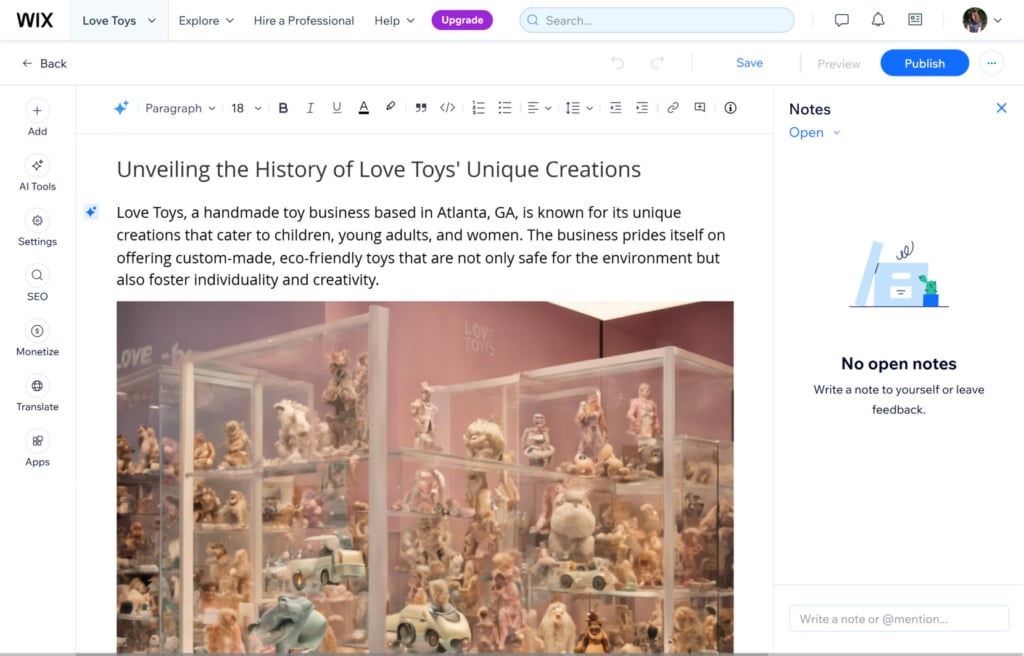
Features:
- Drag-and-drop editor for easy content creation
- App Market for additional integrations (SEO, marketing, etc.)
- Customizable blog layouts and post options
Wix offers artificial design intelligence (ADI) to automatically generate your blog layout based on your preferences. The platform supports ad placements, affiliate marketing, selling digital products, integrating e-commerce through Wix Stores, and subscription-based services via its various apps and integrations.
Pricing: Free plan available; paid plans start at $16/month for more advanced features, including custom domains.
Wix’s ease of use and pre-designed templates make it a great platform for non-technical users looking for an attractive, functional blog that’s easy to set up and maintain.
3. Squarespace
Squarespace is a design-forward website builder that offers robust blogging tools while maintaining an emphasis on aesthetics. It’s favored by many creative professionals and bloggers, boasting millions of users globally due to its elegant templates.
The offered templates and customization options are perfect for those who want to create visually compelling blogs with little technical effort. It also includes integrated analytics to track blog performance and improve your content strategy.
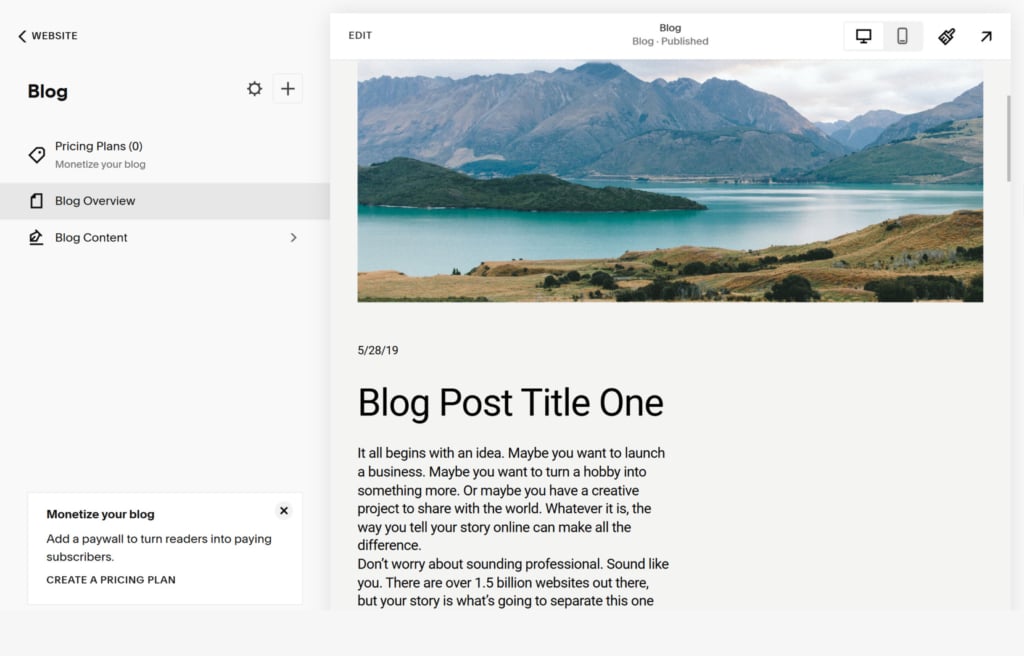
Features:
- Mobile-optimized, responsive templates
- Built-in SEO tools and social media integration
- Post scheduling, tag management, and media galleries
- Customizable layouts for blog posts and pages
The monetization avenues include e-commerce integrations for selling products and services, affiliate marketing, subscription content with member areas, and the ability to incorporate advertising through third-party integrations.
Pricing: No free plan, only a 14-day trial; paid plans start at $16/month.
Squarespace is ideal for bloggers who want a user-friendly platform that combines professional tools for audience growth with beautifully designed templates.
4. Medium
Medium is a minimalist blogging platform that focuses on writing and community engagement, ideal for those who want to share their stories with an established audience. It’s simple to use and doesn’t require any technical skills, making it perfect for writers. Medium allows you to focus purely on creating content while it handles everything else.
The website has millions of active writers and readers and is known for its community-driven content. The Partner Program allows writers to earn revenue through readership and engagement. It also provides exposure within the platform, helping new writers gain visibility quickly.
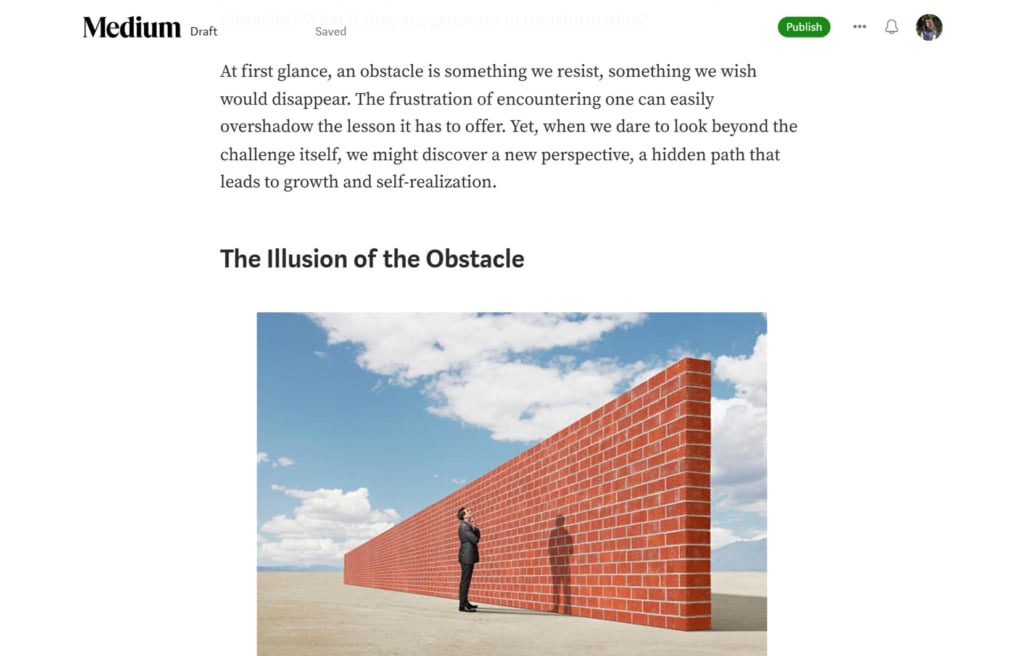
Features:
- Clean, distraction-free writing editor
- Built-in audience through the Medium community
- Tagging system for content discovery
- Paid membership program for monetization
The platform also offers powerful content discovery through its algorithm, which surfaces articles based on reader interests and engagement patterns. This gives writers a chance to reach new audiences organically without extensive marketing efforts.
Pricing: Free to use; $5/month for Medium membership, which grants access to premium content and additional features.
Medium’s simple, clean design allows writers to focus on content rather than technical details. It’s a great platform for those who want to engage with readers while monetizing their content.
5. Blogger
Blogger, owned by Google, is one of the oldest and simplest blogging platforms available, making it a great choice for beginners and hobbyists. It allows users to quickly set up a blog without technical hassle. Google integration ensures ease of use, especially for those already familiar with its ecosystem.
This website is used by millions of bloggers worldwide thanks to its simplicity. The platform supports Google AdSense for easy monetization and offers seamless integration with other Google services, such as Analytics and Drive.
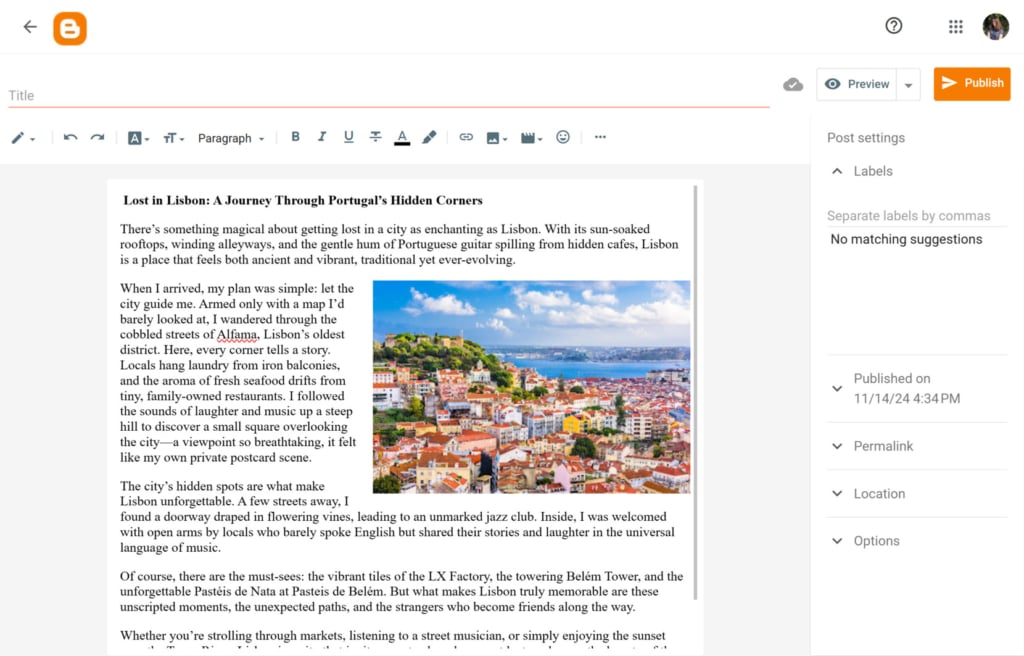
Features:
- Simple blog editor with basic formatting options
- Integrated with Google Analytics and AdSense
- Easy post scheduling and media integration
All users benefit from reliable Google-hosted servers, providing strong uptime and fast loading speeds, which help ensure that blogs run smoothly with minimal technical issues. This stability is a plus for bloggers who want a low-maintenance platform to reach their audience consistently.
Pricing: One of a few free blog sites (with a Blogger subdomain); custom domains available at an additional cost.
Blogger is straightforward and integrates seamlessly with Google’s suite of tools, making it a good starting point for new bloggers. However, it lacks advanced features that more experienced users might desire.
6. Ghost
Ghost is a minimalist, open-source platform built for professional bloggers, journalists, and independent publishers. It is ideal for those who want to publish high-quality content with a sleek design.
This blogging platform focuses on professional publishing, providing tools for creating a paid subscriber base that can receive your post via email. It’s ideal for those looking to monetize their blog through direct memberships.
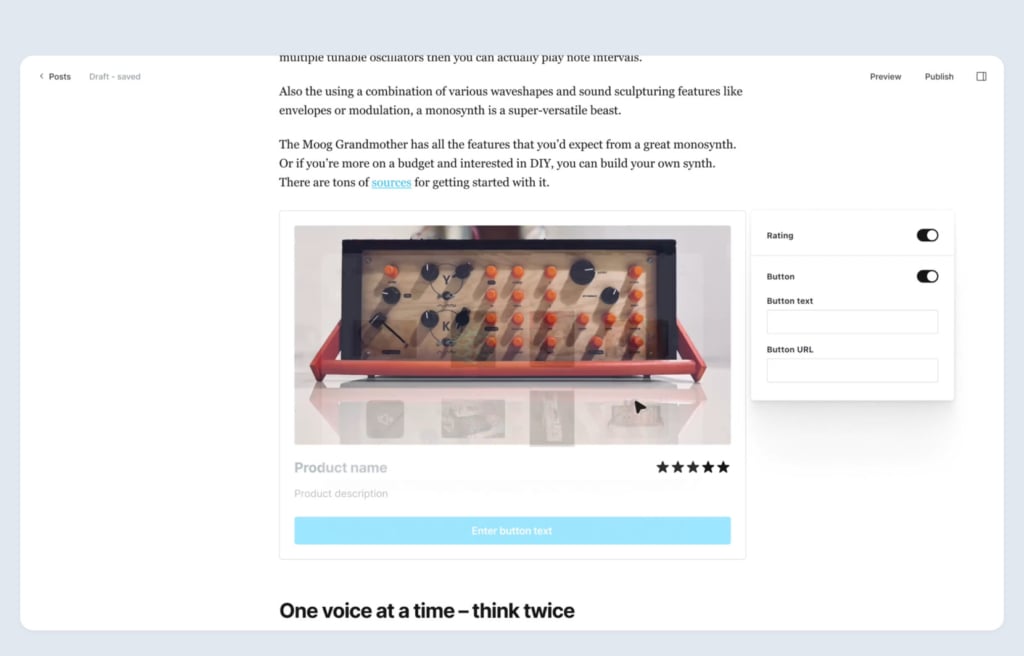
Features:
- Tools for monetization and subscription
- Customizable, clean theme options
- Markdown support for faster writing
- SEO and social sharing integrations
The website is favored by many professionals for its speed, simplicity, and focus on content creation, with a growing user base. You can also integrate e-commerce elements for selling digital products.
Pricing: Plans start at $11/month for managed hosting; self-hosted options available with custom costs.
Ghost’s clean, performance-oriented interface makes it great for writers who want to focus on content. With powerful monetization features, it’s the perfect choice for those looking to build a sustainable writing career.
7. Weebly
Weebly is a simple and user-friendly website builder with a solid blogging platform. It’s particularly useful for those who want to create a blog quickly, without needing any technical expertise.
Now part of Square, this is a widely used blogging website with millions of users, including many bloggers. There are features for selling products and services, ad placements, affiliate marketing, and subscription services integration.
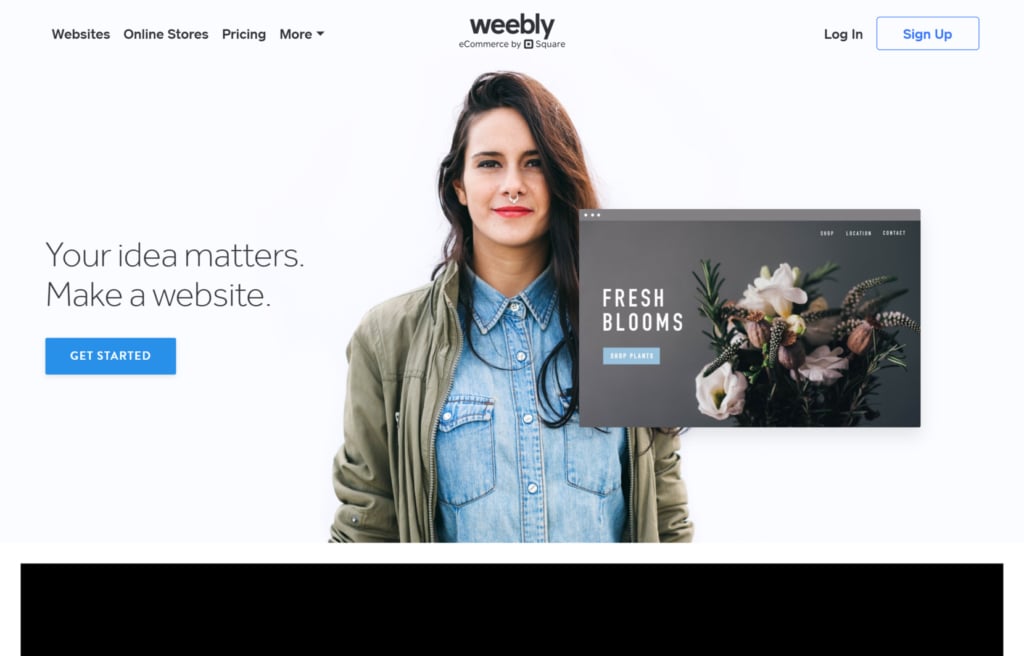
Features:
- Drag-and-drop website editor for easy customization
- Mobile-responsive templates
- Basic blogging tools like text formatting and media integration
- Built-in e-commerce functionality for monetization
The platform stands out for its seamless integration with Square for e-commerce. It also includes free SSL security on all sites, ensuring that your blog is safe and secure for visitors.
Pricing: Free plan available; paid plans start at $10/month for premium features.
Weebly is ideal for bloggers who want to get started quickly, offering simple tools for creating an aesthetically pleasing blog. It’s especially useful for those who also want to integrate an online store or other business tools.
8. HubSpot CMS
HubSpot offers a robust content management system that’s perfect for professionals looking to get the most of the blogging effort. Being part of the broader HubSpot ecosystem, it allows for seamless integration with email marketing, lead generation, and customer relationship management.
The platform enables monetization through integrated e-commerce solutions, affiliate marketing, and utilizing the platform’s analytics to optimize revenue streams. It also offers robust analytics to measure blog performance and audience engagement.
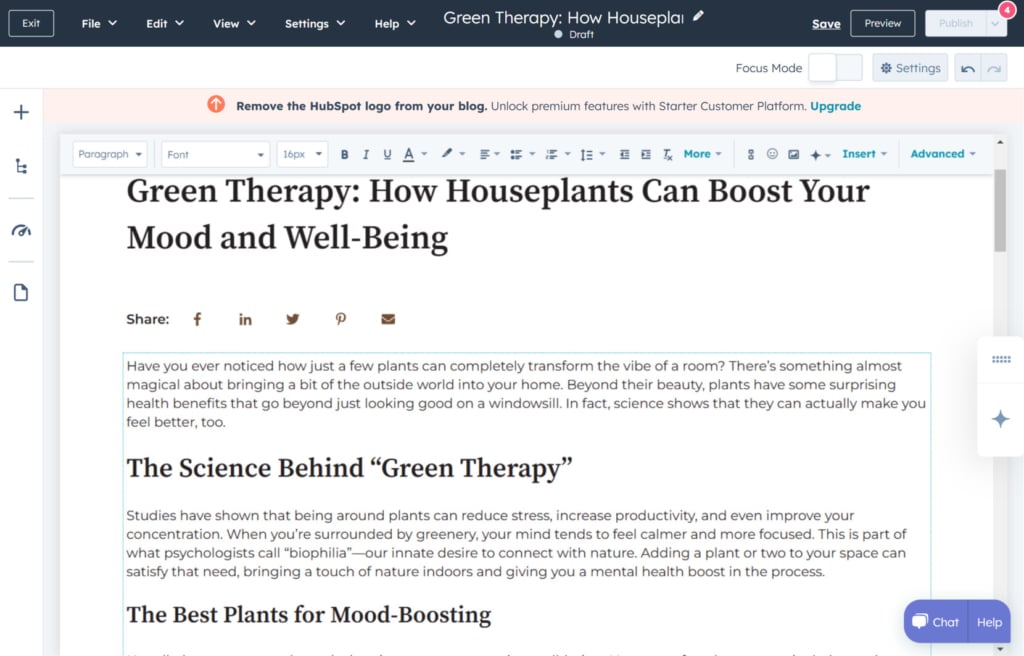
Features:
- Advanced SEO tools and content optimization recommendations
- Built-in CRM integration for lead management
- Mobile-responsive themes and drag-and-drop editor
- Post scheduling, comment moderation, and analytics
The HubSpot’s blog AI feature helps users generate high-quality, SEO-optimized blog content ideas, outlines, and drafts. This will help streamline the writing process and enhance content creation efficiency.
Pricing: Starts at $25/month for the CMS Starter plan.
HubSpot CMS enables businesses to use their blog as part of a comprehensive inbound marketing strategy. It offers valuable insights and tools to optimize blog posts for search engines and generate leads directly from written content.
9. Substack
Substack is a subscription-based blogging platform that enables users to create email-based posts with an easy monetization model. It’s designed for independent writers and journalists who want to build and grow a dedicated subscriber base.
The website is a rapidly growing platform that allows users to create email letters that go directly to the reader’s inbox. It focuses on providing a simple, ad-free environment through a clean intuitive interface.
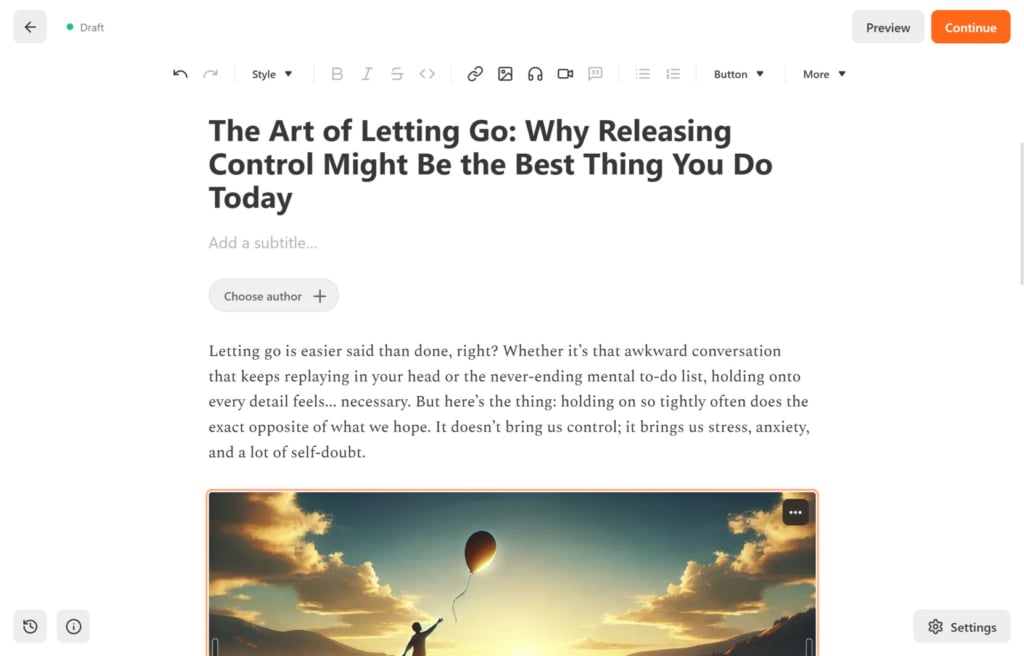
Features:
- Email subscription options for monetization
- Integrated payment processing for paid subscriptions
- Tagging and post scheduling tools
- Simple content editor for easy publishing
Content creators can engage directly with their audience via a chat. There are also tools to see your blog’s statistics. It’s a great platform for anyone who wants to build a loyal readership and make a living out of their writing.
Pricing: Free to use; Substack takes a 10% cut of paid subscriptions.
Substack allows writers to monetize their content by offering paid subscriptions. It’s also a great platform for growing an audience via email, as subscribers are delivered new posts directly to their inbox.
10. Joomla
Joomla is an open-source content management system that offers advanced features for developers and those looking for deep customization. It is highly customizable, making it a great choice for users who need a tailored experience.
The website provides robust blogging capabilities, but requires more technical knowledge than other mentioned platforms. Experienced developers are able to create highly specialized blogs with the offered features.
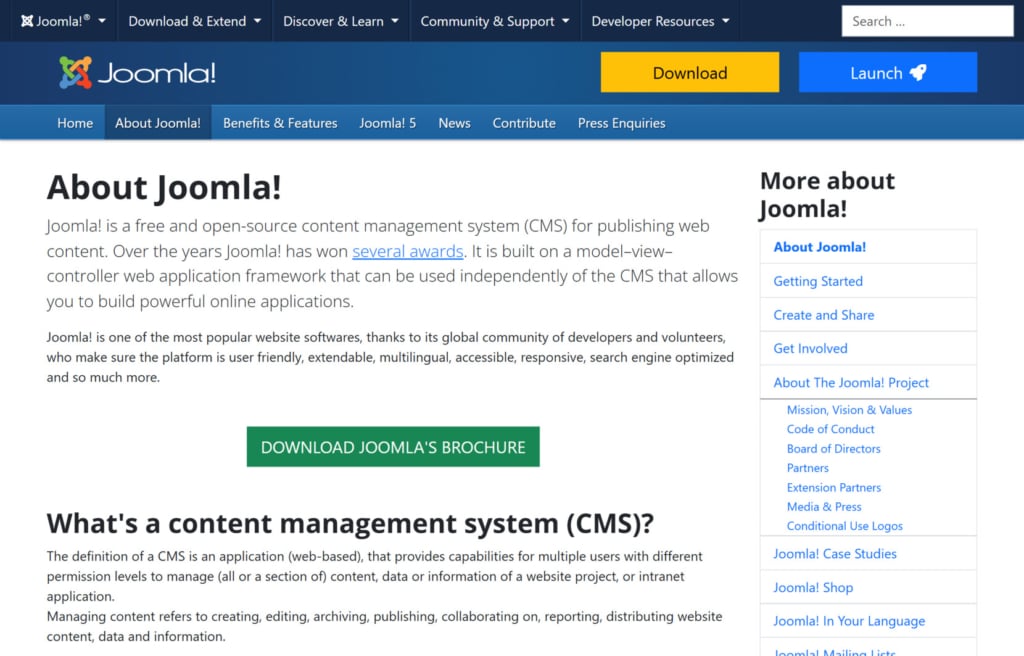
Features:
- Full control over blog design with customizable templates
- Multi-user roles and access control for team collaboration
- Extensive extension library for added functionalities
- Multi-language support and content management
The platform offers monetization options through a variety of extensions, including e-commerce plugins, ad management tools, affiliate marketing integrations, and the ability to create subscription-based content.
Pricing: Free to use; hosting and additional tools come with separate costs, typically starting at $5/month.
Joomla is perfect for users who want to create a highly customized blog with complex features. The platform’s powerful back-end and flexible architecture make it suitable for advanced blogging needs, though it requires coding knowledge.
Choose Smarter Alternatives to Blogging Websites
If a traditional blogging platform doesn’t align with your goals, there are some excellent alternatives that let you share content, build an audience, and express your voice in other ways. Here are three popular options.
Blog Widget for Your Existing Website
If you already have a website but want to add a blog without switching platforms, consider using a blog widget or plugin. The Elfsight Blog widget is an excellent solution for adding a blog to your existing website without the hassle of building one from scratch.
- Diverse templates. Choose from various templates tailored to different blogging intents, such as travel, eco, business, etc.
- Extensive customization. Customize the widget to align with your branding style.
- AI-powered writing. Leverage the AI-powered writing capabilities to generate topic ideas and draft text, simplifying the content creation process.
- Consistent quality. Streamline your workflow to produce high-quality, engaging content consistently.
- Platform compatibility. The Blog widget can be used to create a blog on Wix, WordPress, Squarespace, Shopify, and many other platforms.
- Responsive support. Access the customer support team for assistance, ensuring your blog meets your vision.
- Choose a template that fits your blog’s purpose.
- Configure the layout, features, and design to suit your needs.
- Copy the generated code and integrate it into your website CMS.
Create your own custom Blog widget today using Elfsight’s intuitive editor!
Social media as a blogging platform
Social media platforms like LinkedIn and Instagram make blogging more accessible by offering tools to share content and interact directly with readers. These platforms are ideal for reaching a wide audience without the need for a standalone website. It make blogging more engaging, user-friendly, and cost-effective.
- Built-in features. Leverage LinkedIn and Instagram’s blogging-style tools to connect with readers.
- LinkedIn articles. Publish detailed, professional posts tailored to a business-oriented audience.
- Instagram microblogging. Share stories and insights using captions, carousels, and Stories.
- Ease of use. Interact with followers in a familiar, interactive environment.
- Cost-effective. Enjoy free access to blogging tools without extra setup.
Video blogging (vlogging)
Video blogging, or vlogging, has gained popularity as platforms like YouTube allow creators to transition from written content to engaging visual storytelling. This format is perfect for building a personal brand and fostering a deeper connection with audiences through direct, dynamic interaction.
- Platform popularity. YouTube leads as a top platform for video-based content creators.
- Visual storytelling. Ideal for creators who excel at conveying ideas through video.
- Personal connection. Engage with viewers via comments, live sessions, and other interactive features.
- Monetization opportunities. Earn revenue through ads, memberships, and affiliate links.
- Enhanced engagement. Build stronger audience relationships with dynamic content formats.
Conclusion
In conclusion, the choice for the best blogging platform depends on your goals, technical skills, and intended audience. The described above 10 blog websites provide a variety of features to suit different needs. You also have alternative ways to create a blog like using a website widgets, social media, or video hosting platforms.
Choose the utility that aligns with your vision and helps you connect with your readers best. Ultimately, consistency and creativity are key to having a successful blog.


